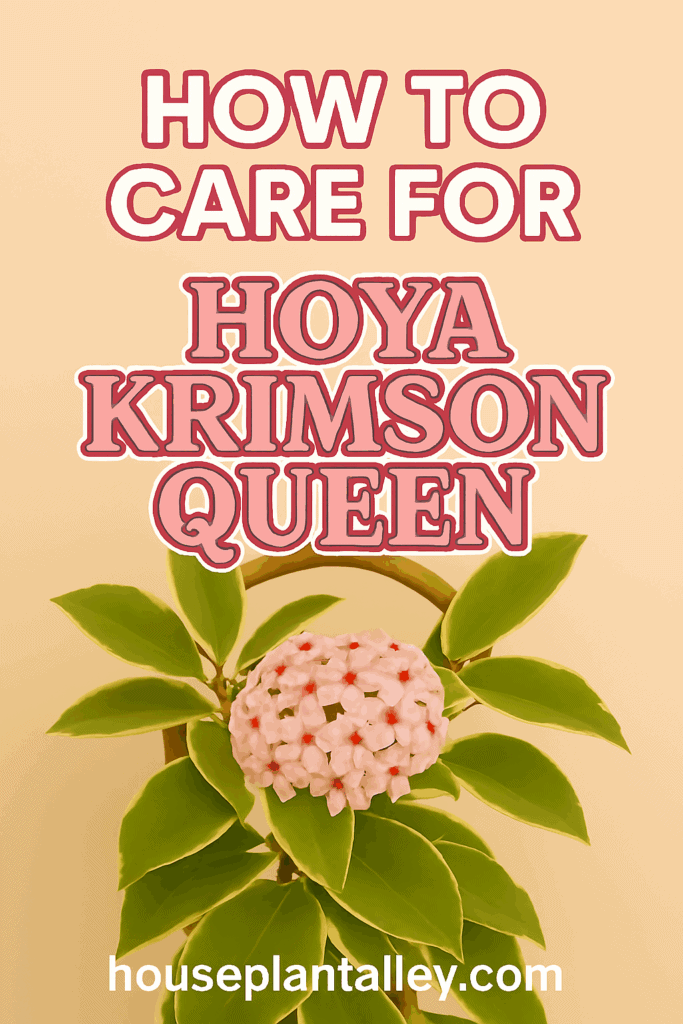Like Goldilocks searching for the perfect porridge, you’ll need to find the “just right” balance when caring for your Hoya Krimson Queen. This stunning variegated beauty isn’t your typical houseplant—it’s got specific preferences that, once mastered, will reward you with cascading vines of pink-edged foliage and fragrant star-shaped blooms. Get the basics wrong, though, and you’ll be left wondering why your plant looks more tragic than magic.

Contents
- 1 Understanding Hoya Krimson Queen Characteristics and Growth Habits
- 2 Selecting the Right Pot and Soil for Optimal Growth
- 3 Light and Temperature Requirements for Healthy Development
- 4 Proper Watering Techniques and Fertilization Schedule
- 5 Repotting Guidelines and Timing Considerations
- 6 Troubleshooting Common Issues and Pest Management
- 7 Propagation Methods and Maintenance Best Practices
Understanding Hoya Krimson Queen Characteristics and Growth Habits
When you first encounter a Hoya Krimson Queen, you’re looking at a stunning cultivar of Hoya carnosa from the Apocynaceae family. The waxy leaves showcase remarkable leaf variegation with cream, pink, or white edges that’ll catch your eye immediately.
You’ll notice its trailing growth patterns make it perfect for hanging baskets or training on supports. The plant’s also known as Wax Plant or Honey Plant because of its nectar production. Previously called ‘Tricolor’ until the trademark expired in the 1970s, this beauty stores water in its semi-succulent leaves, making care surprisingly manageable for most gardeners.
Selecting the Right Pot and Soil for Optimal Growth

Now that you understand your Hoya Krimson Queen’s natural characteristics, choosing the right foundation becomes your next priority. Terra cotta pots work best since they allow moisture to escape naturally. Avoid oversized containers – they’ll actually prevent flowering by retaining too much water.
For soil composition, you’ll need excellent drainage above everything else. Mix standard potting soil with bark chips and perlite, or simply use orchid mix straight from the bag. This mimics their native epiphytic environment perfectly.
Light and Temperature Requirements for Healthy Development
While your potting choices create the foundation, getting the lighting conditions right determines whether your Hoya Krimson Queen will thrive or merely survive. You’ll want bright, indirect light—think filtered sunlight through a sheer curtain. Direct sun burns those gorgeous variegated leaves, turning them dull and brown.
Aim for 10,000-20,000 lux using a light meter for precision. Your plant craves consistent temperatures around 75°F, with minimal temperature fluctuations that stress the foliage. Keep humidity above 50%, ideally 60% or higher.
Monitor light intensity regularly, adjusting placement seasonally as sun angles change throughout the year.
Proper Watering Techniques and Fertilization Schedule
The secret to watering your Hoya Krimson Queen lies in patience, not frequency. These semi-succulent beauties store water in their waxy leaves, so they’d rather be slightly thirsty than drowning. Let the soil dry almost completely between waterings, checking moisture with your finger or a meter.
Your watering frequency should decrease in early spring, mimicking their native drought conditions. For ideal nutrient balance, use liquid fertilizer during growing season for quicker absorption. Focus on NPK ratios with secondary micronutrients to support healthy growth and encourage those coveted fragrant blooms you’re working toward.
Repotting Guidelines and Timing Considerations
Since Hoya Krimson Queen plants prefer staying cozy in their current homes, you’ll only need to repot every 2-3 years for young plants, or every 3-4 years for established ones. Spring or early summer offers the best timing for this task. Watch for telltale signs like roots poking through drainage holes, stunted growth, or yellowing leaves.
Choose terra cotta pots that allow moisture escape, avoiding oversized containers. For soil amendments, mix bark and perlite into regular potting mix, or simply use orchid mix. Keep soil levels consistent, gently tease roots apart, and water thoroughly after transplanting to guarantee proper drainage.
Troubleshooting Common Issues and Pest Management
Even with proper repotting and care, your Hoya Krimson Queen might still face challenges that require quick identification and action. Yellow leaves typically signal overwatering or poor drainage, while brown patches indicate sunburn from direct light. Dull colors or lost variegation suggest insufficient brightness.
For pest identification, check regularly for aphids, spider mites, and mealybugs on leaf undersides and stems. These tiny invaders cause leaf discoloration and stunted growth. Treat infestations immediately with insecticidal soap or neem oil applications.
Wilting stems usually mean watering issues—either too much or too little. Adjust your schedule accordingly.
Propagation Methods and Maintenance Best Practices
Once you’ve mastered basic care, propagating your Hoya Krimson Queen becomes an exciting way to expand your collection or share with friends. These propagation techniques are surprisingly simple and rewarding.
Start with healthy stem cuttings about 4 inches long, using clean, sharp scissors. Remove lower leaves, then root in water or well-draining soil. You’ll see roots developing within 2-3 weeks.
For maintenance tips, try the layering method by pinning a vine section into a neighboring pot while still attached to the parent plant. This natural approach guarantees successful root formation before separating your new plant.
